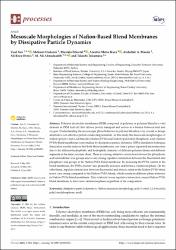Mesoscale Morphologies of Nafion-Based Blend Membranes by Dissipative Particle Dynamics

View/
Access
info:eu-repo/semantics/openAccessDate
2021Author
Sen, UnalOzdemir, Mehmet
Erkartal, Mustafa
Kaya, Alaattin Metin
Manda, Abdullah A.
Oveisi, Ali Reza
Ali Aboudzadeh, M.
Tokumasu, Takashi
Metadata
Show full item recordAbstract
Polymer electrolyte membrane (PEM) composed of polymer or polymer blend is a vital element in PEM fuel cell that allows proton transport and serves as a barrier between fuel and oxygen. Understanding the microscopic phase behavior in polymer blends is very crucial to design alternative cost-effective proton-conducting materials. In this study, the mesoscale morphologies of Nafion/poly(1-vinyl-1,2,4-triazole) (Nafion-PVTri) and Nafion/poly(vinyl phosphonic acid) (Nafion-PVPA) blend membranes were studied by dissipative particle dynamics (DPD) simulation technique. Simulation results indicate that both blend membranes can form a phase-separated microstructure due to the different hydrophobic and hydrophilic character of different polymer chains and different segments in the same polymer chain. There is a strong, attractive interaction between the phosphonic acid and sulfonic acid groups and a very strong repulsive interaction between the fluorinated and phosphonic acid groups in the Nafion-PVPA blend membrane. By increasing the PVPA content in the blend membrane, the PVPA clusters' size gradually increases and forms a continuous phase. On the other hand, repulsive interaction between fluorinated and triazole units in the Nafion-PVTri blend is not very strong compared to the Nafion-PVPA blend, which results in different phase behavior in Nafion-PVTri blend membrane. This relatively lower repulsive interaction causes Nafion-PVTri blend membrane to have non-continuous phases regardless of the composition.

















